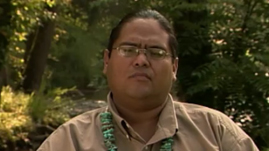Teachers' Domain - Digital Media for the Classroom and Professional Development
User: Preview



Albert Brent Chase, artistic director of The Pollen Trail Dancers, explains the purposes of dance in Navajo culture. He notes that dance is a form of honoring one’s self and the connection with one’s surroundings; that dance has a healing purpose; and that dance and songs are ways of carrying on traditional teachings and history of the Navajo people. The Pollen Trail Dancers are from the Navajo lands north of Joseph City, Ariz., an area that includes the Painted Desert and Petrified Forest.
This resource is part of the Native American Culture collection.
Find additional arts resources for your classroom at the KET Arts Toolkit website.
The Navajo call themselves Diné, which means simply “the people.” The Navajo Nation occupies the largest native land area in the United States, encompassing more than 27,000 square miles in Utah, Arizona, and New Mexico. In terms of numbers of people, the Navajo is the second largest Native American group in North America.
According to archaeologists, the Navajo migrated into the American Southwest from the sub-Arctic sometime in the 13th century. They still live in the heart of their traditional homeland. Originally a hunting and gathering people, the Navajo people took up sheep herding soon after they arrived in the Southwest. Many Navajo still raise sheep. The sheep provide meat as well as wool for the Navajo’s famous beautiful woven blankets. In addition to blankets, Navajo craftspeople create pottery, baskets, and jewelry of silver and turquoise.
The Dance of the Deities, shown in the first part of the video, represents the origin of the Navajo people. It has been modified to protect the sacred nature of the dance. There are certain prayerful words that are called out during the traditional dance, but these are not included when the dance is done in public as an educational performance. Dancing is generally fairly slow and contained, as the dancers may be expected to dance for hours.
The number four is entwined into the dance in many ways. The dancers repeat many movement patterns four times, turning to face each direction. Symbolically, they are dancing to the four holy mountains of Dinetah, another word for the Navajo homeland.
The dance demonstrates the Navajo belief that the four directions are the sacred pillars of life, just as the four sacred mountains in Dinetah are the homes of the Holy People. Four of the dancers wear regalia representing the four directions. The east is always the first direction acknowledged, just as traditional Navajo hogans were always built so that the doorway faces east to greet the dawn. Each direction is associated with a certain color. White is for the east, blue for the south, yellow for the west, and black for the north. Dance steps are repeated in each of the four directions throughout the dance.
 Loading Standards
Loading Standards